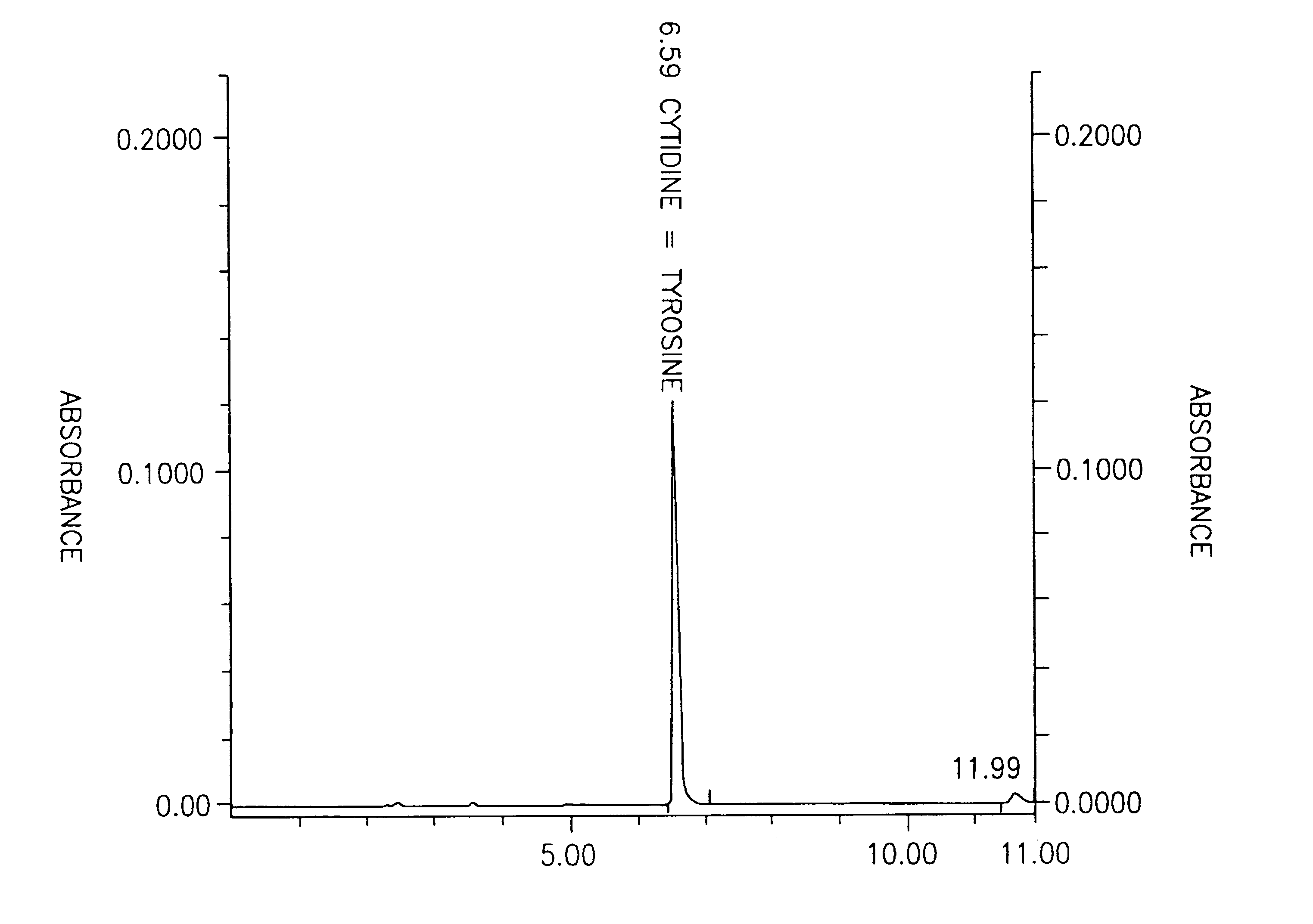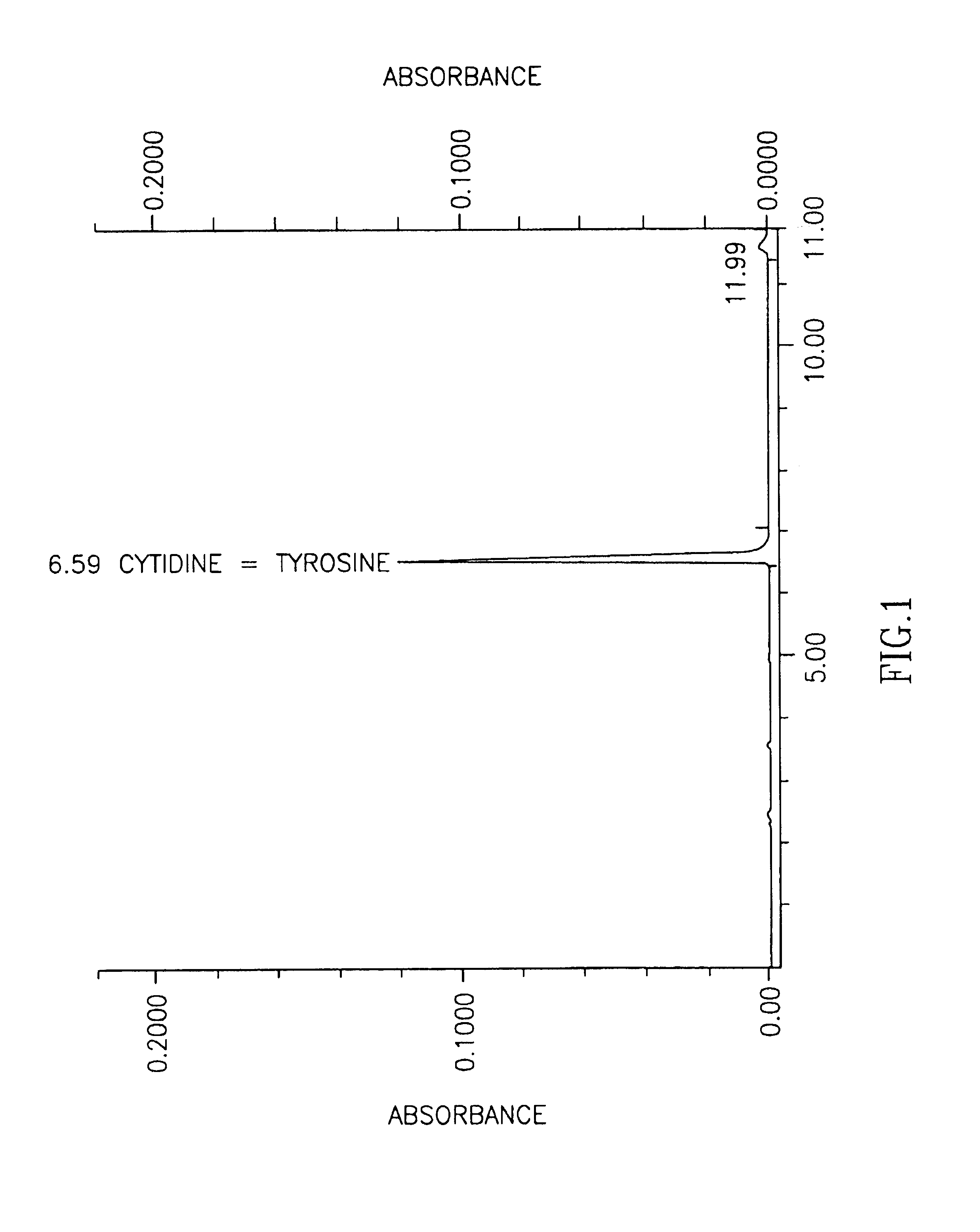Methods for increasing blood cytidine and/or uridine levels and treating cytidine-dependent human diseases
a technology of cytidine and uridine, which is applied in the direction of biocide, cardiovascular disorder, drug composition, etc., can solve the problems of insufficient activity of the enzyme, inability to cross or be much less efficient than uridine, and insufficient prior art relating to the process of uridine to cytidine conversion. , to achieve the effect of enhancing uridine bioavailability
- Summary
- Abstract
- Description
- Claims
- Application Information
AI Technical Summary
Benefits of technology
Problems solved by technology
Method used
Image
Examples
example 1
[0041]In this example a new method is established that overcomes the problem of the coincidence of cytidine and tyrosine peaks when tested by a standard HPLC method for measuring various nucleosides in biological fluids (see FIG. 1). By using the standard HPLC method, one can, however, easily distinguish the uridine peak from the cytidine peak. Detailed description of the HPLC method can be found for example in Lopez-Coviella et al., (Evidence that 5′-cytidinephosphocholine can affect brain phospholipid composition by increasing choline and cytidine plasma levels. J. Neurochemistry 65: 889-894, 1995). Modified HPLC is carried out in a same way as standard HPLC except that elution buffer contains low amount of methanol (0.1%) instead of formic acid and as a result cytidine can be distinguished from unrelated compound tyrosine (FIG. 2). This method is useful in distinguishing cytidine from masking effect of amino acid tyrosine, which may concomitantly be present in tested biological f...
example 2
[0042]Gerbils, rather than rats or other rodents, are selected for this example, as the pyrimidine metabolism of said gerbils is closer to humans. For practical and ethical reasons humans cannot always be used for certain experimental studies and those skilled in the art generally recognize that the gerbil model is equivalent to a human model. Indeed, gerbils are the model of choice for certain human diseases and brain disorders such as cerebral ischemia (Ginsburg et al., Rodent models of cerebral ischemia. Stroke 20:1627-1642, 1989). Gerbils are given uridine orally and 60 minutes later plasma and brain levels of cytidine and uridine are measured by the modified HPLC method described in Example 1. FIG. 3 shows the relative ratio between uridine and cytidine levels in plasma after oral administration of 250 milligram per kg of body weight (mg / kg) of uridine. FIG. 4 shows the relative ratio between uridine and cytidine levels in the brain after oral administration of 250 mg / kg of und...
example 3
[0043]In Example 3 a clinical study is carried out with the goal of treating memory disorders and cognitive dysfunctions associated with aging as well as memory decline and cognitive dysfunction associated with pathological conditions like Alzheimer's disease, Pick's disease, Lewy Body disease, and / or dementias like Huntington's disease and AIDS dementia. Patients with non-pathological dementia associated with aging are also included. Oral doses of uridine alone ranging from 5 mg to 50,000 mg are administered daily to five male and five female patients suffering from one of the diseases listed above. The adjustment in dosage to select optimally effective pharmaceutical dose is a routine procedure well known to the practitioner skilled in the relevant art. The terms “therapeutically” or “pharmaceutically” or “pharmacologically effective dose” of a drug as used hereinafter means the amount (dosage) of the drug that provides desired clinical effect in at least 10% of treated patients” ...
PUM
| Property | Measurement | Unit |
|---|---|---|
| Level | aaaaa | aaaaa |
Abstract
Description
Claims
Application Information
 Login to View More
Login to View More - R&D
- Intellectual Property
- Life Sciences
- Materials
- Tech Scout
- Unparalleled Data Quality
- Higher Quality Content
- 60% Fewer Hallucinations
Browse by: Latest US Patents, China's latest patents, Technical Efficacy Thesaurus, Application Domain, Technology Topic, Popular Technical Reports.
© 2025 PatSnap. All rights reserved.Legal|Privacy policy|Modern Slavery Act Transparency Statement|Sitemap|About US| Contact US: help@patsnap.com



